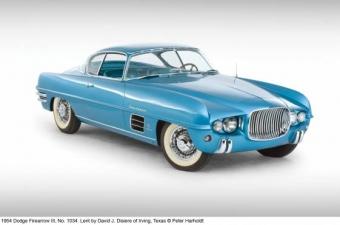
Section Branding
Header Content
Alluring Autos: When Are Cars Art?
Primary Content

Bugatti, Alfa Romeo, Pierce Arrow, Porche -- these are among the high-class cars on display in a new exhibit at the High Museum of Art in Atlanta. The Allure of Automobile show features 18 hand-made, exclusively designed cars that date from 1933 to 1961.
When you walk off the elevator that opens onto the exhibit, the massive car in front of you is – pun intended – traffic stopping.
GROSS: "If you know the expression 'It’s a Duesy.' We’re looking at a Duesy."
Curator Ken Gross says getting attention was exactly the point of this pale yellow, convertible 1935 Duesenberg JN Roadster. It gets its name from Duesenberg brothers, German immigrants who designed the car in Auburn, Indiana. The long, flat hood reaches toward the spacious, open cab, interrupted only by a short windshield. Two spare tires stacked on the trunk make the car look a block long. Silver external side pipes stick out above the classic, white-wall tires. Actress Carol Lombard bought this Duesy for her husband Clark Gable because it was the most powerful American car of its day.
GROSS: "420 cubic inches. 265 horsepower. And if you paid a little more you got 320 and a supercharger. A lightweight Duesenberg would do 102 miles an hour in second gear."
And it reeked of money. Even the engine block was painted green – the color of cash. In the early 1930’s, a Ford Deluxe Fordor cost $610 dollars. This Duesy cost about 20 grand. In today’s money, this gift to her hubby would have cost Ms. Lombard nearly a million dollars. But why again is this car art?
GROSS: "What is art when you think about it. Well, beauty in the eye of the beholder. People are struck by the magnificence of some of these cars. Many of these cars were handmade. They were exclusively designed. I think they embody a lot of the characteristics that we consider art."
Like paintings or sculptures, these cars come from wealthy collectors all over the world. They embody some of the greatest design of the 20th century. Take the Pierce-Arrow Silver Arrow. It was built to compete in the 1933 Chicago International Exposition. Gross says the car’s designer Phil Wright took his cues from the design craze of the time Art Deco.
GROSS: "The spare tires which normally would be on the running board, are concealed under the fenders. And there’s a tiny, tiny rear window that buts to a V. It has the purity of line, it has the styling clichés that today we wouldn’t do but in those days someone would look at this car and say it’s perfect, it’s just right."
And it was ahead of its time, known as a concept car. It was like a test to see what Americans wanted in their cars a few years down the line. Gross says high design in expensive, exclusive automobiles trickled down to consumer models. It happened then, and it happens now.
GROSS: "To some degree the concept cars of today -- what we would call dream cars that you would see in an auto show -- are really looking 3 to 5 to 8 years ahead of contemporary design. The idea is to gauge the opinion of the public to have them at it and say 'whoo that scares me a little or boy I like that, when can I buy it?' They can gauge somehow what they think people will want."
So next time you sit in your car, think about it, you might be riding in what started out as a piece of art.
Tags: Rickey Bevington, car, All Things Considered, Allure of the Automobile, High Museum of Art, art, Pierce-Arrow, Duusenberg, Clark Gable, Carol Lombard, Ken Gross
Bottom Content

